Haswell and GK110 vs. Ivy and GK104: DigitalStorm Virtue System Review
by Dustin Sklavos on June 23, 2013 12:00 PM ESTSystem and Gaming Performance
The two subjects we want to examine with the DigitalStorm Virtue and its 4.4GHz Intel Core i7-4770K are whether or not the overclocking plateau really has stayed level over the past two or three generations of Intel CPUs, and just how close GK104 can really get to GK110. Remember that the GeForce GTX 770 actually ships with memory clocks higher than most GTX 680s could attain, and memory bandwidth was frequently the bottleneck with GK104.
An important comparison to keep in mind: the 4.6GHz Intel Core i7-3770K is only clocked about 5% faster than the new 4.4GHz i7-4770K. Haswell tends to be roughly 10% faster clock per clock than Ivy, so with some dirty math it would take about a 4.8GHz i7-3770K to make up the performance gap.
As for the overclocked GTX 680 against the GTX 780, that's a bit trickier. The 780 is working with almost 50% more memory bandwidth, and with some extremely dirty math, about 20% more shader power. That's before you try to calculate the GTX 780's boost clocks, which are much jumpier than the GTX 680's. Even missing an entire SMX cluster, GK110 is still a bear compared to the more svelte GK104.
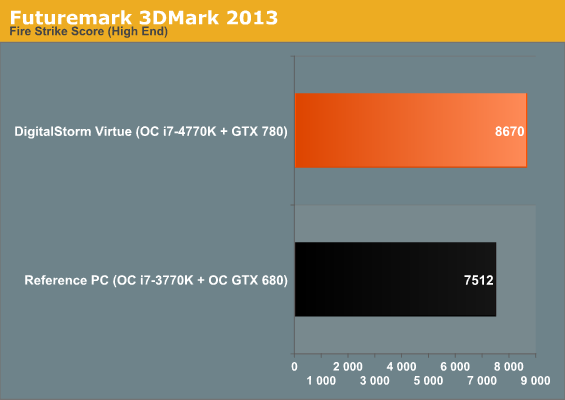
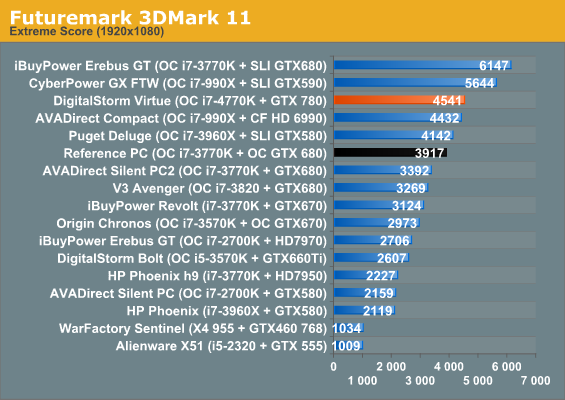
The 3DMarks pretty much tell the story. In both 3DMarks, a stock 780 is still ~15% faster than a heavily overclocked GTX 680.
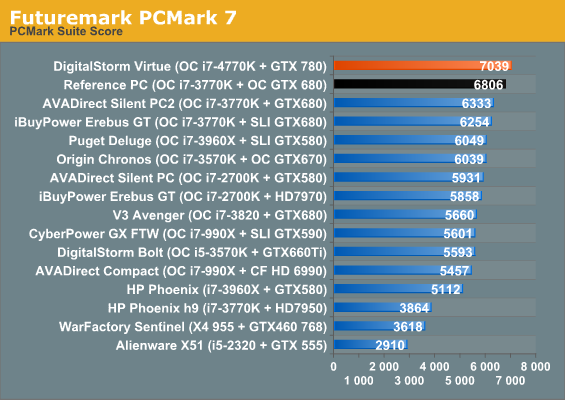
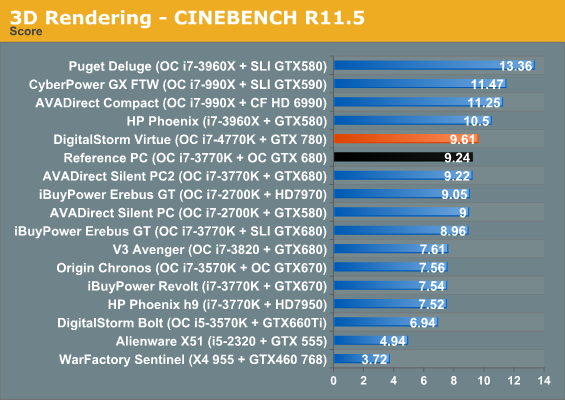
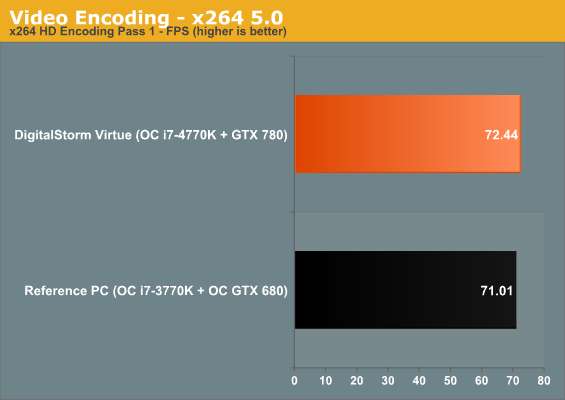
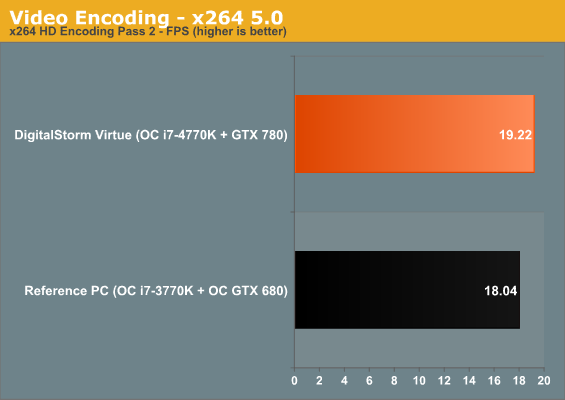
While PCMark7 tends to simply favor newer, faster SSDs, the difference between Haswell and Ivy gets a lot uglier when we isolate CPU performance. Consensus is that we've lost a bit of overclocking headroom with Haswell, making the comparison between a 4.6GHz Ivy and 4.4GHz Haswell a reasonably fair one. Cinebench is just 5% faster on Haswell, the first pass of the x264 benchmark is a dismal 2% faster on Haswell, and the second pass is at least a slightly healthier 7%.
Also note the improvement from Sandy to Ivy in Cinebench, though: our fastest Ivy is just 2% faster than our fastest Sandy. That Sandy was also running at 4.6GHz. Ivy at least brought a fat reduction in power consumption and TDP from Sandy despite the mediocre IPC improvement, but Haswell actually increased power consumption.
The math gets even uglier when we compare Sandy to Haswell. A 4.4GHz i7-4770K is only 6% faster than a 4.6GHz i7-2700K. That means that in two subsequent generations, the performance ceiling has barely moved. Anand is keen to point out that Intel's ability to eke out ~10% additional IPC on the same 22nm process node with a new architecture is impressive, and that may be true from a technical perspective, but Intel has offered enthusiasts virtually nothing new for two generations running. So whether or not the technical achievement is notable, end users are still left holding the bag. At this point, if you're hankering for more performance on the CPU, your best bet is actually to either go for an i7-3930K or wait for Ivy Bridge-E and hope Intel doesn't bone us with thermal paste instead of fluxless solder again. The only real selling point of Haswell, as far as I'm concerned, is access to the Z87 chipset.
Thankfully, while the jump in price from the NVIDIA GeForce GTX 680 to the GTX 780 isn't a particularly happy one, at least that dial moved pretty substantially. We tested every game at our Enthusiast settings (essentially maxed out and topping out at 4xMSAA), at 1920x1080 and then at 5760x1080.
|
GTX 680 1080p |
GTX 780 1080p |
% Perf. Increase |
GTX 680 Surround |
GTX 780 Surround |
% Perf. Increase |
|
| BioShock Infinite | 83.1 | 91.6 | 10.2% | 32.5 | 37.1 | 14.2% |
| Elder Scrolls V: Skyrim | 93.4 | 104.1 | 11.5% | 72.1 | 75.7 | 5% |
| GRID 2 | 87.3 | 109.2 | 25.1% | 39.4 | 49.2 | 24.9% |
| Metro: Last Light | 36.7 | 40.7 | 10.9% | 13.7 | 15.7 | 14.6% |
| Sleeping Dogs | 90 | 101.2 | 12.4% | |||
| StarCraft II: Heart of the Swarm | 73.5 | 86.2 | 17.3% | |||
| Tomb Raider | 64.3 | 72.5 | 12.8% | 31.8 | 36.5 | 14.8% |
So how do we interpret these results? First, excluding the outlying Skyrim surround results, even a diehard overclocked GTX 680 user can expect to net at least 10% more power from the GTX 780. Bumping up to 5760x1080 actually even lets the GTX 780 start to stretch its legs; while the 680 seems to be limited either by memory capacity or memory bandwidth, the 780's 384-bit memory bus and extra 1GB of GDDR5 do a solid job of picking up the slack.
Remember, too, that this is all before you overclock the 780. The consensus right now seems to be that the 780 has a very healthy amount of overclocking headroom, more than the 680 did, so if you're willing to sacrifice some power consumption and noise, you can theoretically push the 780 to Titan levels and even a bit beyond. At that point, it will pull away substantially from the 680 and by extension, the 770. I'm planning to do a custom liquid cooling review in the near future to get a grasp of just how far we can reasonably push a pair of GTX 780s, and given that I regularly see boost clocks of about 1GHz on them with just air cooling and no overclocking, I'm pretty optimistic.










70 Comments
View All Comments
JimmiG - Tuesday, June 25, 2013 - link
You *will* be able to pay extra for a properly TIM'ed CPU but it won't be another $20. You'll be looking at the IB-E and upcoming Haswell-E which will be several hundred more than their LGA1150 equivalents, with more expensive motherboards thrown in for good measure.airmantharp - Monday, June 24, 2013 - link
So, 1000W PSU's are just for shits and giggles? It couldn't draw more than 500w in the worst load situations, and 750W PSU's covering dual-GPU setups are far more reasonable.danjw - Monday, June 24, 2013 - link
Any chance you could be convinced to see what you could do by deliding the i7-4770K changing the internal TIM, and see what you can do with it? I would really like to find out what the real top end to Haswell is, without Intel's nerf.Ubercake - Tuesday, June 25, 2013 - link
This is kind of a creative way to give Haswell a numeric boost. How about both systems with 780s? Probably not much of a difference whatsoever.When AMD starts creating meaningful CPUs again, we'll see Intel get back into competition mode. Until then, they'll just keep selling CPUs with ever-so-slight increases.
Klimax - Tuesday, June 25, 2013 - link
I doubt we'll ever again see GHz race, because energy density is getting very high .(Smaller chip is, more heat per mm needs to be transferred)And without huge complexity, per-clock performance is walled too. (And GPU show how such complexity works with yields)
AndersP - Tuesday, June 25, 2013 - link
If you choose to buy a 780 GTX over a 770 GTX, you gain 10-20% performance increase for 70% higher price.You have to pay 20% more if you choose to buy 770gtx SLI rather than a single 780 GTX for a 50-60% performance increase. In addition, a 770 GTX is a lot cheaper, faster and better temperatures than 680 GTX. Not sure, about new features such as shadowplay and automated performance/temperature control also works with older models.
In my eyes 770 GTX is defiantly very viable. If you want the most for your buck.
godrilla - Tuesday, June 25, 2013 - link
My 3 year old rig with i7 980 xe at 4.3 ghz and 1 year old gtx 690 1150/6500 mhz is still top notch.halcyon - Wednesday, June 26, 2013 - link
These kind of meagre performance upgrades are the reason I'm not upgrading. Yes, I have the cash. In fact, it's burning in my pocket.But a 10% or so improvement at best over what I have?
Even my secondary 2009 system has a 3-channel memory subsystem that can actually feed four cores, unlike Haswell chipsets.
GTX670 and GTX770 offer almost zip improvements for my CUDA based workload.
But I'm not complaining, I can spend this money on better digigams, new phone, new tablet, etc.
At least there have been _substantial_ improvement on those, unlike in CPU/GPU performance of the past years.
Bluejay234 - Monday, July 22, 2013 - link
As good as the Digital Storm build looks, the sad truth is that there is STILL no compelling reason to buy a new Digital Storm system, when the 2600k based one I bought at the beginning of 2011 is almost as powerful as anything I can get today (and overclocks better).Drittz121 - Friday, February 28, 2014 - link
Just do yourself a favor. STAY AWAY from this company. Yes they look good. But when it breaks and it WILL. All they do is give you the run around. They have had my system for over 2 months trying to fix the garbage they sell. Worse company out there for support. DONT BUY